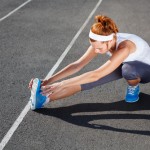
In the woodland we enjoy stretching and encourage other Elves to stretch to increase range of movement (ROM) and reduce delayed onset muscle soreness (DOMS) after exercise. However some of our Elf colleagues apply a “no pain, no gain” approach to stretching, often with mixed results. We wanted to give our friends the best advice about the most effective way to stretch. After pondering the effect of stretch on connective tissue and whether higher intensity stretches actually increase inflammation, we wondered if anyone else had asked this question. We found this review whose purpose was to investigate how stretch intensity and body position may impact and influence the soft and connective tissue.
Here’s what they did
Three databases were consulted (PubMed/Medline, Google Scholar, and Cochrane reviews), in order to determine stretch intensity and its association to stretching. (MeSH) terms, “stretch” and “stretching exercises,” were utilized in combination with “ROM,” “DOMS,” and “inflammation” in four different populations: athletes, clinical, elderly, and general population. The athlete group consisted of all studies mentioning an athletic activity, which included only athletes, the clinical group concerned patients with any disease/injury, and the elderly group included individuals of 65+ years of age. The general group comprised all remaining studies not adhering to the criteria set for the three other groups.
Quality of studies was assessed using a checklist (Jadad et al. 1996) where points were ascribed for randomisation, blinding and number and the reasons for participant withdrawal. The maximum score was five and the minimum for an included report was one. Scores of three or greater were deemed of high quality. Studies that did not meet any of the criteria were excluded from the literature review.
Here’s what they found
From 195 unique titles, 152 articles were included in the review (Athlete n = 24; Clinical n = 29; Elderly n = 12; General n = 87).
- Athlete – all 24 studies mentioned duration and frequency, only 12 referenced intensity. Five out of seven studies that combined loaded stretch with an intensity of discomfort and pain noticed no improvement. One study examined supported stretch of either gentle or discomfort intensity and found gentle supported stretch had the greatest gains in active and passive ROM.
- Clinical – all 29 mentioned duration and frequency, seven referenced intensity. This group of studies were primarily focused on ROM with greater dependency on machines or therapists to achieve optimal stretch. Contradicting results were reported, however two low quality studies found benefit with supported stretch positions.
- Elderly – all 12 studies reported duration and frequency, five referred to intensity. The main focus in this group was ROM. In all studies a supported stretch was used, there were no loaded stretches. Benefits were related to a supported self stretch or the participants being stretched by a therapist in a supported position (e.g lying on plinth).
- General – all 87 studies in this group referenced duration and frequency, 55 mentioned intensity. A loaded stretch with higher intensity (i.e. discomfort, pain) showed no definite beneficial trend. However studies describing intensity where a supported stretch position was used did show benefits.
The authors concluded
…due to the lack of good quality studies, it is difficult to draw conclusions about the effects of stretching intensity and/or position on the observed effects of stretching.

Due to the lack of good quality studies, it is difficult to conclude about the effects of stretching intensity and position.
The Musculoskeletal Elf’s view

This was an interesting review, unfortunately the article does not detail dates for the literature search but the oldest included article was published in 1977 and the most recent in 2015.
Although the quality of the studies was not high, the results seem to suggest that supported stretch shows benefit compared to unsupported stretch. The authors concluded that the intensity is relatively under-researched, and the importance of body position and its influence on stretch intensity, is largely unknown. Must pass these findings onto the Elves!
What do you think?
- How far is far enough when stretching?
- When do you achieve the best results with your stretching?
Send us your views on this blog and become part of the ever expanding Musculoskeletal Elf community. Post your comment below, or get in touch via social media (Facebook, Twitter, LinkedIn, Google+).
Links
Apostolopoulos, N., Metsios, G. S., Flouris, A. D., Koutedakis, Y., & Wyon, M. A. (2015). The Relevance of Stretch Intensity and Position: A Systematic Review. Frontiers in Psychology, 6, 1128 [Abstract].
Jadad, A. R., Moore, R. A., Carroll, D., Jenkinson, C., Reynolds, D. J. M., Gavaghan, D. J., & McQuay, H. J. (1996). Assessing the quality of reports of randomized clinical trials: is blinding necessary? Controlled clinical trials, 17(1), 1-12 [Abstract]

What about stretch intensity and position? http://t.co/ZE86zcdBDJ